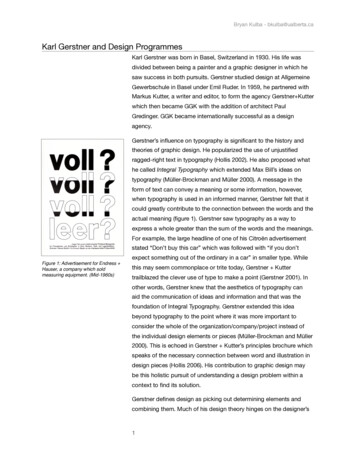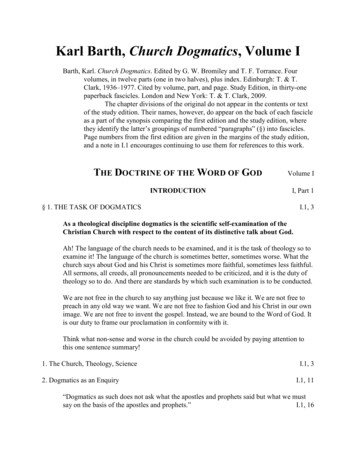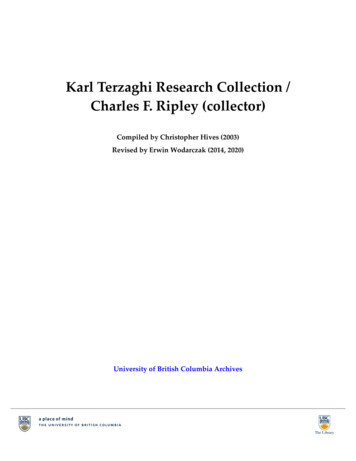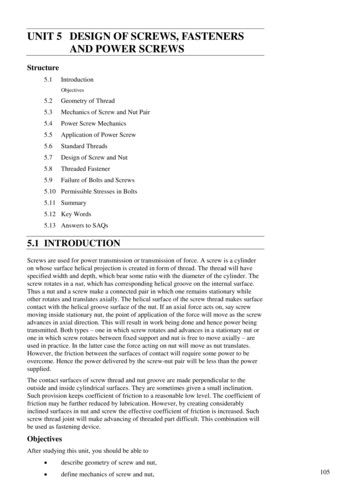
Transcription
Bryan Kulba - bkulba@ualberta.caKarl Gerstner and Design ProgrammesKarl Gerstner was born in Basel, Switzerland in 1930. His life wasdivided between being a painter and a graphic designer in which hesaw success in both pursuits. Gerstner studied design at AllgemeineGewerbschule in Basel under Emil Ruder. In 1959, he partnered withMarkus Kutter, a writer and editor, to form the agency Gerstner Kutterwhich then became GGK with the addition of architect PaulGredinger. GGK became internationally successful as a designagency.Gerstner’s influence on typography is significant to the history andtheories of graphic design. He popularized the use of unjustifiedragged-right text in typography (Hollis 2002). He also proposed whathe called Integral Typography which extended Max Bill’s ideas ontypography (Müller-Brockman and Müller 2000). A message in theform of text can convey a meaning or some information, however,when typography is used in an informed manner, Gerstner felt that itcould greatly contribute to the connection between the words and theactual meaning (figure 1). Gerstner saw typography as a way toexpress a whole greater than the sum of the words and the meanings.For example, the large headline of one of his Citroën advertisementstated “Don’t buy this car” which was followed with “if you don’texpect something out of the ordinary in a car” in smaller type. WhileFigure 1: Advertisement for Endress Hauser, a company which soldmeasuring equipment. (Mid-1960s)this may seem commonplace or trite today, Gerstner Kuttertrailblazed the clever use of type to make a point (Gerstner 2001). Inother words, Gerstner knew that the aesthetics of typography canaid the communication of ideas and information and that was thefoundation of Integral Typography. Gerstner extended this ideabeyond typography to the point where it was more important toconsider the whole of the organization/company/project instead ofthe individual design elements or pieces (Müller-Brockman and Müller2000). This is echoed in Gerstner Kutter’s principles brochure whichspeaks of the necessary connection between word and illustration indesign pieces (Hollis 2006). His contribution to graphic design maybe this holistic pursuit of understanding a design problem within acontext to find its solution.Gerstner defines design as picking out determining elements andcombining them. Much of his design theory hinges on the designer’s1
ability to make informed choices based on understanding of theproblem and the combinations of elements. To come to a problem’ssolution, the designer must be able to describe and understand theproblem. By then developing a set of intellectual criteria, the designeris able to make ‘creative decisions’ which are based on a systematicapproach instead of instinct (Gerstner 1964).The set of ‘intellectual criteria’ that Gerstner speaks about can alsobe seen as a set of consciously derived parameters which directlyaddress the problem the designer has identified. These parameterscan then be used to work through the problem to find a solutionwhich is a combination of the determining elements which conveythe intended message. For Gerstner, these criteria took the form ofa systematic set of rules or parameters which he referred to as aprogramme. In 1964, Gerstner wrote Designing Programmes whichoutlined his theories.Defining ProgrammesIn reference to computers, a programme is defined as “a sequence ofinstructions that a computer can interpret and execute” (FreeDictionary 2010). While computers were in their infancy in Gerstner’stime, his approach to programmes is very similar to that ofcomputers. In his theories, a programme is a systematic approach tosolving a problem which comes from an understanding of a problem.It is important to note that the approach is responsive and oftenunique to the specific problem. Interestingly, Gerstner illustrates thata programmatic approach to problems is not limited to graphic designbut many vocations from literature to music to photography toarchitecture. For each, a programme is different but in all cases,it comes from defining the problem and then enables the designer,musician, writer, photographer or architect to systematically try tosolve that problem. With Gerstner’s pursuits as a graphic designerand a painter, we can see his programmatic approach manifest itselfin two different, but equally systematic ways.To remain in the realm of graphic design, I will outline two examplesof how Gerstner used programmes in different ways.2
Gerstner’s Morphological Typogram systemThe development of logos or wordmarks is a common task for thegraphic designer. Invariably, it involves experimentation andgeneration of many variations to find the best solution for the logo.Gerstner’s (1968) morphological typogram programme (Figure 2) wasintended as a way for designers to systematically produce a numberof variations of a wordmark. It lists a number of parameters of type onthe left column and then each one is broken into how that particularparameter can be modified or treated. For example, typeface isbroken down into san-serif, roman, german, some other or acombination of typefaces.Figure 3: Wordmark for IntermöbelFigure 2: Gerstner’s Morphological TypogramBy generating variations with this programme, the designer does nothave to rely on randomly creating variations, but can systematicallycreate variations. From these, the designer can quickly determine agood approach to the wordmark and then develop a solution.3
With Gerstner’s example of the Intermöbel wordmark, we see his finalsolution was derived from the combination: a-11, 21, 33; b-14, 22;c-12, 22, 33, 41; d-11, 22, 31, 43.The strength of this programme is that it allows the designer todevelop a number of wordmarks through the systematic combinationsof a list of defined parameters. This keeps the designer from havingto randomly think of type variations for developing iterations of awordmark. The programme is not a replacement for creativity,however. Once designer generates a version that has somethinginteresting about it or addresses the design problem, they can thenfocus on refining that idea. The programme allows the designer toexpend their creative energy on the refinement of a good idea insteadof a large number of ideas which may not address the problem.Grid for the CapitalThe use of grids was popularized and refined by Swiss designers likeJosef Müller-Brockmann and is one of the signature characteristics ofSwiss style of graphic design (Hollis 2006). Grids are a programmethat sets a number of parameters through columns, gutters andmargins which allow designers to generate creative layouts quicklybut also maintains a consistency in between elements on a page orbetween pages of a document. Karl Gerstner was the first to trulyexploit grids and create them with unmatched complexity whichyielded incredible flexibility.In 1962, Gerstner was commissioned to design a quarterly magazinecalled Capital (figure 4). It was a magazine intended to put the ideasof economics into a human perspective and so it needed to be clear,aesthetically pleasing, and engaging. He considered grids to be a“ reliable regulating tool for layout, tables, pictures, etc., a formalprogram, a priori, for a give quantity of unknown content” (Gerstner2001). The grid provides a set of guidelines to consistently lay outunpredictable content.4
Figure 4: Grid for Capital magazine. 1962Grids can turn design into a simple act of placement of elements intoa series of column. While this can provide the consistency, grids canbe a trap for designers; creating uninspired, homogenous layouts.This is especially the case with simple grids. For Capital, Gerstnerdeveloped an complex grid which was flexible and allowed rapid,creative and consistent layouts. As a grid grows in complexity, itprovides “a maximum number of constants with the greatestpossible variability” (Gerstner 2001).The grid looks incredibly complex at first, but upon examination,shows itself as a number of grids overlaid upon each other (figure 5).While each grid overlay was often used separate, they were designedso if columns were mixed together, they would still maintain aharmony between each other. This way the magazine’s layout isconsistent from page to page and between the different grid versions,separate or combined.5
Figure 5: Variations within grid layers.Application of Programatic Principles to DesignWhat is interesting about Gerstner’s concepts of programmes is howthey were conceived well before the impact of computers was trulyfelt by humanity. The ideas that Gerstner had laid out in DesigningProgrammes are almost more relevant to design in the computer agethan they were when he wrote them (Cooper 1989). The connotationsof program(me)s in regard to creativity and the links betweengenerative programs and aesthetics have been debated in the past(Franke 1989). More recently, the idea of programmes in design arecommonplace as designers are more involved in the web and digitalmediums. Understanding and utilizing this approach has becomedeeply connected to design process (Lupton and Cole Phillips 2008).With the necessity to learn languages like html or systems like css(cascading style sheets), the designer becomes more comfortablewithin structure and Gerstner’s concepts start to make sense andapropos to the design process.Beyond the implications of computers and technology, why areGerstner’s concepts of programmes important to designers?6
Programmes are a way to introduce economy into a design process.Gerstner asserted that programmes are a means of developing astructure to be creative in. While a structure can be seen as limiting, itcan also be seen as establishing the parameters of a design problemwhich can keep a designer focused. By integrating a systematicapproach to ideation, iteration or composition, a designer can reducethe time spent on randomly arriving at solutions. This time saved inthe early stages can then be used later on to refine and improveconcepts. For example, Gerstner’s typogram programme allows forrapid and systematic generation of a number of possibilities for awordmark. The programme itself, does not offer the answer oranything new, but it clears the designer’s mind of needing to conceiveiterations so they can focus on the design problem and its needs.Programmes allow designers to keep from starting from scratch everytime. A grid provides the designer with something that they can usefrom layout to layout for a magazine or document as a starting point.The success in any programme relies on its adequacy and robustnessin addressing the design problem. As a grid is developed, it isimportant that its design is informed by the design problem it isaddressing. The grid allows the designer to rapidly lay out pages in aninformed manner. In the case of Capital magazine, the grid was alsocomplex enough that it was flexible and provided ample opportunityfor the designer to be creative in their explorations laying out thepages. This complexity liberates the designer from the constraints ofthe simple grid by offering incredible possibilities and variations forlayouts while maintaining consistency between elements, pages andissues. The creativity that the Capital grid affords is proof in itself thatrules can provide a framework to solving a design problem withoutdetermining the final result (Lupton and Cole Phillips 2008). The grid isnever the answer to the design problem, it is just provides informedguidelines to arrive at the answer.ConclusionThere are two aspects of design process which are central toGerstner’s theories. First is creativity. Gerstner’s evangelism forintroducing programmes into design process is not to limit creativity,but to ensure creative energy is efficiently allocated to the stageswhere it most benefits answering the design problem. Instead of7
energy expended during the preliminary stages, clever use ofprogrammes and frameworks can allow the designer to operatesystematically and quickly. Once the seed of an idea or solution haspresented itself through a systematic approach, creativity can takeover to improve and refine the idea.The second fundamental aspect of Gerstner’s theories is theimportance defining and understanding of the design problem.Gerstner (1968) saw describing the problem as intrinsic to arriving at asolution and he saw a problem as never having a single solution:“Instead of solutions for problems, programmes for solutions —the subtitle can also be understood in these terms: for noproblem (so to speak) is there an absolute solution. Reason: thepossibilities cannot be delimited absolutely. There is always agroup of solutions, one of which is the best under certainconditions.” (Gerstner 1968)Once the design problem has been carefully defined, then anappropriate programme could be developed to explore solutions. Thefailure of a programme comes when it is not developedcomprehensively enough or does not regard the design problemadequately. For example, the morphological typogram programme(Gerstner 1968) uses the matrix of parameters and variations of typeto derive a wordmark. This programme may not produce a decentdesign solution if it is not comprehensive enough to address thedesign problem or its solutions. This is especially relevant now, as thevast number of typefaces available to a designer today is not satisfiedwith Gerstner’s “24. Some other” category for typeface choice. Thelesson from this is that a programme must always be reactive to thedesign problem, and also to what cannot be predicted as in the caseof grids which may house any variety or combination of content. Thecomplexity or flexibility that a designer works into a programme bythoroughly understanding the design problem should reduce oreliminate the cases where programmes fail.In the end, programmes can never be considered the answer to asolution; they are just a tool to help the designer arrive at a solution toa design problem.
To remain in the realm of graphic design, I will outline two examples of how Gerstner used programmes in different ways. 2. Gerstner’s Morphological Typogram system The development of logos or wordmarks is a common task for the graphic designer. Invariably, it involves experimentation and generation of many variations to find the best solution for the logo. Gerstner’s (1968) morphological .











